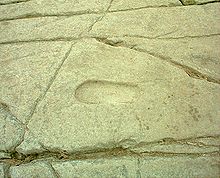This article may require cleanup to meet Wikipedia's quality standards. The specific problem is: Many of the legends retold in this article are stated as if they were factual accounts, particularly in § The devil. (June 2019) |

A petrosomatoglyph is a supposed image of parts of a human or animal body in rock. They occur all over the world, often functioning as an important form of symbolism, used in religious and secular ceremonies, such as the crowning of kings. Some are regarded as artefacts linked to saints or culture heroes.
The word comes from the Greek πέτρα (petra, 'stone'), σῶμα (soma, 'body'), and γλύφειν (glyphein, 'to carve'). Feet are the most common; however, other features including knees, elbows, hands, heads and fingers are also found.
Stylised representations of parts of the body are often open to dispute and are therefore on the fringes of acceptability as identifiable petrosomatoglyphs. Natural objects, such as rock crystals and rock formations which look like petrosomatoglyphs, whole animals, plants, etc., are collectively called "mimetoliths".
- ^ Revealed: carved footprint marking Scotland's birth is a replica, The Herald, 22 September 2007.